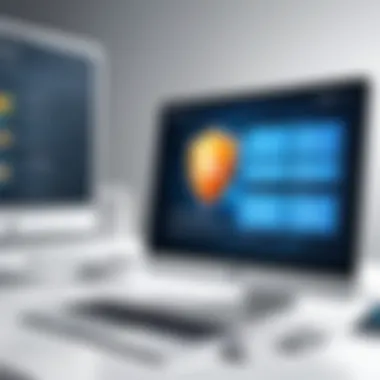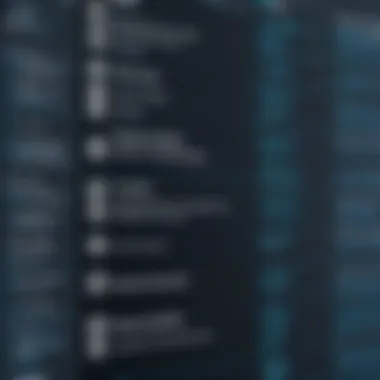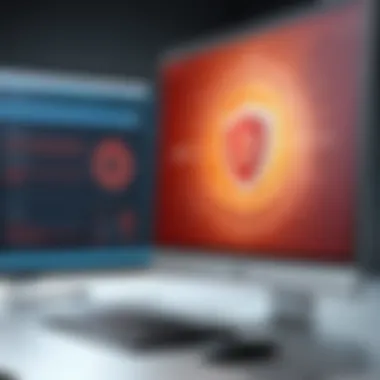Top Antivirus Solutions for IT Professionals: A Comprehensive Review


Intro
The importance of cybersecurity cannot be overstated in today's digital era. With the constant evolution of threats, IT professionals need reliable antivirus solutions that not only protect their systems but also provide valuable features for effective management. This article aims to delve into the best antivirus options on the market, focusing on their suitability for technology experts.
Through detailed assessments of features, pricing, and user experience, we intend to equip you with vital knowledge. As cyber threats become increasingly sophisticated, having the right antivirus software is essential for maintaining security in any organization.
Features Overview
In the realm of antivirus solutions, understanding the key features can vastly influence your decision-making. Below we examine the specifications and unique selling points that differentiate these products.
Key Specifications
- Real-Time Scanning - Continuous monitoring of files to detect threats instantly.
- Malware Removal - Capable of thoroughly removing both pests and residual files left behind.
- Firewall Integration - Protects against unauthorized access while managing outgoing and incoming traffic.
- Phishing Protection - Guards against deceptive websites and online scams.
- System Resources Management - Minimizes impact on system performance during scans.
Unique Selling Points
- Ease of Use: Many top antivirus solutions feature intuitive interfaces.
- Advanced Threat Protection: Utilizing machine learning and AI to prevent emerging threats.
- Cross-Platform Compatibility: Availability on various operating systems such as Windows, macOS, and Linux.
- Customer Support: Robust support services, including forums, live chats, and tutorials.
Effective antivirus software is more than just a shield; it integrates seamlessly into the workflow of IT professionals, ensuring safety without compromising efficiency.
Performance Analysis
Assessing the performance of antivirus solutions is crucial. This section presents benchmarking results and relatable real-world scenarios that exemplify how these solutions operate under pressure.
Benchmarking Results
Various antivirus options undergo rigorous testing to determine their efficacy. These tests typically gauge:
- Detection Rates: How many threats are detected compared to the total threats encountered.
- Speed: The time taken to complete scans and update databases.
- Impact on System Performance: Evaluating how much resources are utilized during scans and routine activity.
Real-world Scenarios
Understanding how antivirus software performs in everyday situations is vital. For instance, a company experiencing a sudden uptick in phishing attempts would benefit from solutions with robust phishing protections. Similarly, businesses managing multiple devices need solutions that can filter threats across platforms efficiently.
By evaluating these aspects, IT professionals can make informed choices based on actual performance rather than just specifications.
Understanding Antivirus Solutions
The field of cybersecurity hinges significantly on the effectiveness of antivirus solutions. Understanding these tools is crucial for IT professionals as threats evolve and become increasingly sophisticated. This section will illuminate the essential nature of antivirus software and its role in maintaining secure systems. By grasping the fundamental aspects of these solutions, professionals can make informed choices to protect their digital assets adequately.
Definition and Purpose
Antivirus software refers to programs designed to detect, prevent, and remove malware from computers and networks. Malware encompasses various harmful software types, such as viruses, worms, trojans, and spyware. The primary purpose of antivirus solutions extends beyond mere detection; they also include quarantine of identified threats, automatic updates to combat new forms of malware, and in some cases, violation of privacy rights to safeguard users' data.
The core functions of antivirus software typically include:
- Real-Time Protection: Continuously monitoring system activities to identify and block suspicious behavior.
- Virus Scanning: Regularly scanning files and systems for existing threats.
- User-Friendly Interface: Ensuring ease of use for individuals who may not have extensive technical knowledge.
- Updates: Automatic updates that add new signatures to the malware database to address the latest threats.
With these functions, antivirus software forms a critical line of defense against cyber threats, which can compromise sensitive information and disrupt operations.
Importance of Antivirus Software for IT Professionals
The importance of antivirus software for IT professionals cannot be overstated. In a constantly connected environment, the risks that cybersecurity threats pose will only rise. Notable reasons for the significance of antivirus solutions include:
- Protection Against Advanced Threats: Emerging cyber threats such as ransomware and zero-day exploits necessitate robust antivirus solutions. Without them, systems are exposed to potential breaches and data losses.
- Regulatory Compliance: Many organizations must adhere to industry regulations regarding data protection. Having adequate antivirus solutions in place is often a requirement to meet compliance standards.
- Operational Integrity: Cyber-attacks can result in downtime and significant recovery costs. Antivirus software is paramount in sustaining the smooth functioning of IT operations by preemptively neutralizing threats.
- Enhanced Trust: Clients and end-users increasingly prefer to engage with organizations that demonstrate a commitment to cybersecurity. Utilizing reputable antivirus solutions fosters trust and enhances the organization’s reputation.
"Investing in antivirus software is not just a defense mechanism; it is a proactive step towards ensuring business continuity and integrity."
Criteria for Evaluating Antivirus Software
Evaluating antivirus software is crucial for making informed decisions in cybersecurity. The right antivirus solution not only protects systems from threats but also ensures minimal disruption to productivity. IT professionals need to focus on several elements when assessing antivirus options. This section highlights those criteria.


Effectiveness in Threat Detection
The core function of antivirus software is to detect and neutralize threats. Therefore, effectiveness in threat detection is a top criterion. This involves examining the software's ability to identify various malware types, such as viruses, worms, trojans, ransomware, and spyware. Advanced detection methods, like heuristic analysis and machine learning capabilities, often enhance effectiveness.
Moreover, up-to-date virus definitions are essential for timely detection of emerging threats. Regular updates ensure the software can recognize new malware variants and adapt to evolving tactics used by cyber criminals.
System Performance and Resource Usage
System performance is another important consideration. Antivirus solutions should run efficiently without consuming excessive system resources. High resource consumption can lead to sluggish performance, affecting daily operations of IT professionals.
Moreover, benchmarking tests often reveal how different antivirus solutions impact overall system performance. Evaluating memory usage, CPU load, and disk space consumption during scans can provide critical insights. Efficient software should balance security with performance, allowing users to work seamlessly.
User Interface and Usability
A clean and intuitive user interface enhances usability, especially for IT professionals who may have varying levels of familiarity with technology. The software should offer straightforward navigation, allowing users to access features without extensive training.
Customization options are beneficial too. Users should be able to adjust settings based on their specific needs. For example, running quick scans or deep scans should be easily configurable. A well-designed interface can significantly improve the efficiency of managing antivirus tasks.
Pricing Models and Plans
Assessing pricing models helps IT departments manage budgets effectively. Antivirus software often offers different plans, catering to a range of user needs. It is important to compare pricing alongside features offered in each plan.
Some antivirus solutions provide basic protection at low costs, while others may include premium features, such as cloud storage and VPN services for higher fees. Understanding what is included in each plan allows for better decision-making.
Customer Support and Resources
Responsive customer support can be a lifesaver for IT professionals. The level of support provided, including availability of resources like tutorials, FAQs, and community forums, greatly influences user experience.
Some antivirus companies offer 24/7 support, while others may provide limited assistance. Evaluating access to specialists, response times, and the availability of additional resources can enhance the usability of the software in a busy IT environment.
Top Antivirus Software Options
In the domain of cybersecurity, the selection of antivirus solutions plays a critical role in safeguarding both personal and organizational assets. The Top Antivirus Software Options delineate a spectrum of choices that cater to varied security needs, particularly for IT professionals who navigate complex digital environments.
The effectiveness of antivirus software can directly influence an organization’s ability to mitigate risks associated with malware infections, phishing attacks, and other cyber threats. Therefore, understanding this section's nuances is essential for making informed decisions. Key elements such as detection rates, system resource usage, and user experience significantly impact the selection criteria for best-suited solutions.
Leading Solutions Overview
There are several prominent antivirus solutions availabe today that stand out among the competition. These products are engineered with advanced technologies and protocols to combat a diverse range of threats. Products such as Bitdefender, Norton, and Kaspersky are recognized leaders in this field. They provide distinctive features that cater to enterprise needs while ensuring robust protection.
- Bitdefender
Known for its high performance in malware detection, it employs a multi-layered approach, boosting resilience against evolving threats. Its cloud scanning capabilities enhance real-time protection. - Norton
Offers comprehensive security solutions with a focus on identity protection and secure VPN services. It’s useful for both individuals and businesses seeking to secure sensitive information. - Kaspersky
This solution is characterized by a user-friendly interface coupled with strong protection metrics. Kaspersky is especially noted for minimal impact on system resources.
These solutions each offer unique advantages that help users navigate the challenges of cybersecurity, making them central choices for many organizations.
Comparison of Key Features
When evaluating antivirus solutions, certain key features can differentiate one product from another significantly.
Consider the following essential aspects:
- Threat Detection Effectiveness
Reliable antivirus software must demonstrate high detection rates across a range of malware types. This effectiveness often correlates with the product's ability to ward off zero-day threats and polymorphic viruses. - System Performance
A common concern with antivirus software is its impact on system performance. Leading solutions find a balance, ensuring thorough scanning while maintaining responsiveness. - User Interface
Usability matters. An intuitive interface can reduce the barrier to using complex security features, making tools accessible even for less technically inclined users. - Price and Value
The pricing models can vary greatly. Organizations should assess not just the upfront cost but also the potential value and return on investment, particularly through features like automatic updates and customer support. - Customer Support
Quality customer support can be a deciding factor. It is essential that users have access to timely assistance and comprehensive resources when necessary.
"Selecting the right antivirus solution is not just about protection; it's also about ensuring smooth operational continuity for an organization."
An understanding of these features allows IT professionals to align their security strategy with the organizational needs effectively. As technology progresses, evaluating these key elements for potential antivirus solutions will remain vital.
In-Depth Reviews of Notable Antivirus Products
In the realm of cybersecurity, a comprehensive review of notable antivirus products is essential. This enables professionals to assess which solutions align best with their specific needs. Each product brings distinctive features and capabilities that cater to various use cases. Evaluating these aspects can greatly assist in choosing the right antivirus software for protecting sensitive data and systems.
Product A: Analysis
Overview


Product A is a well-known antivirus solution that focuses on providing robust protection against malware, spyware, and other cyber threats. Its cloud-based threat analysis is a pivotal characteristic, enabling it to adapt quickly to emerging threats. This makes it a popular choice among IT professionals due to its effectiveness in real-time detection and prevention of cyber-attacks. A unique feature of Product A is its automated patch management, which helps keep software up to date, reducing vulnerabilities.
Strengths
The strengths of Product A include its high malware detection rates and user-friendly interface. These characteristics contribute significantly to its reputation, making it a favored option for many organizations. Moreover, the software leverages machine learning algorithms, which enhance its detection capabilities. This is particularly beneficial, as it minimizes the chance of false positives, resulting in a smoother user experience while maintaining security.
Weaknesses
Despite its advantages, Product A has some weaknesses. One issue is that it can be resource-intensive, particularly on older systems. This can result in slower performance, impacting overall productivity. Additionally, the pricing structure may not be favorable for small businesses looking for cost-effective solutions. These factors should be considered before making a decision.
Product B: Analysis
Overview
Product B stands out with its integrated firewall system and customizable security settings. This product is designed for IT professionals seeking enhanced control over their security configurations. Its primary strength lies in its multi-layered security approach, offering protection at various levels. This versatility makes it suitable for diverse environments and user requirements.
Strengths
The key characteristic of Product B is its extensive reporting capabilities. It allows users to track security events and system activity in detail. This feature is particularly valuable for compliance with industry regulations. Furthermore, the product exhibits strong performance regarding remediation solutions, offering guidance on how to resolve security threats quickly and effectively.
Weaknesses
However, Product B does present certain weaknesses. Its user interface can be complex, making it challenging for less experienced users to navigate. Additionally, while it offers a wealth of features, some users report that the initial setup process may be cumbersome. These considerations are important for organizations prioritizing ease of use.
Product C: Analysis
Overview
Product C positions itself as an economical alternative without compromising on security features. It includes basic antivirus protection, anti-phishing tools, and a web shield. These core functionalities provide a solid foundation for businesses that seek reliable protection at a lower cost. Its appealing pricing makes it attractive for startups and smaller organizations with limited budgets.
Strengths
The product's affordability is one of its defining strengths. It provides a good balance between cost and essential security features. Additionally, Product C has been noted for its lightweight installation, which minimizes disruptions during deployment. This ease of implementation can be a strong advantage for organizations looking to initiate security measures quickly and effectively.
Weaknesses
On the downside, Product C lacks some advanced features found in more comprehensive solutions. Functions like advanced threat detection or real-time response capabilities might not be as effective. This limitation could concern IT professionals working in high-risk environments or those dealing with sensitive data. Understanding these constraints is vital before selection.
Emerging Trends in Antivirus Technology
Antivirus technology is constantly evolving due to shifts in technology and methodologies of cybercriminals. In today's landscape, understanding these emerging trends is essential for IT professionals. Not only does it define the tools they must consider, but it also deeply influences organizational strategies in mitigating risks. As threats become more complex, so too must the solutions meant to counter them. This segment focuses on two pivotal trends: the integration of artificial intelligence and machine learning, and the adaptation required to meet evolving threat landscapes.
AI and Machine Learning in Cybersecurity
Artificial Intelligence (AI) and Machine Learning (ML) have become critical components in modern antivirus solutions. Their application in cybersecurity is transformative, allowing for real-time threat detection and automated responses. AI algorithms analyze vast datasets to identify patterns indicative of malicious activity. As these algorithms learn from previous threats, they become increasingly proficient at predicting and preventing attacks.
Some advantages of using AI and ML in antivirus software include:
- Increased Detection Rates: AI can detect known threats and anticipate new ones based on patterns and behaviors.
- Faster Response Times: Automation allows for quicker isolation of threats, reducing potential damage.
- Reduced False Positives: Machine learning models improve accuracy, resulting in fewer unnecessary alerts for users.
Despite their benefits, reliance on automated systems does raise concerns about false confidence and the potential for oversight in critical areas. Hence, human expertise should still play a vital role in cybersecurity strategy.
Adapting to Evolving Threat Landscapes
Cyber threats are in a continuous state of flux, with trends such as ransomware, phishing schemes, and zero-day exploits becoming more prevalent. For antivirus software to remain effective, they must evolve alongside these threats. Antivirus providers are increasingly focusing on a few key strategies:
- Behavioral Analysis: Instead of solely relying on signature-based detection, many solutions now monitor behavior during runtime to identify suspicious activity.
- Cloud-Based Solutions: Many modern antivirus solutions are moving to the cloud, allowing for greater processing power and the ability to leverage shared intelligence. This enables quicker updates and access to extensive databases of threats.
- User Education and Awareness: Companies are recognizing that technology alone cannot protect against human error. Training programs that educate users about safe practices can significantly reduce vulnerability to attacks.
"With the rapidly changing nature of threats, it is crucial to prioritize adaptable technologies and ongoing education."
As the digital landscape grows more intricate, IT professionals must stay informed about these trends. Knowledge of emerging technologies will empower them to make informed decisions about their cybersecurity tools and practices.


Best Practices for Using Antivirus Solutions
Using antivirus solutions effectively is essential to ensure the optimal security of IT environments. A strong antivirus program does not just protect against incoming threats; it requires proactive management. For IT professionals, understanding the best practices is crucial. This reduces potential risks and enhances overall cybersecurity posture.
Regular Updates and Maintenance
One of the most significant practices involves keeping antivirus software current. Software updates are vital as they often contain the latest virus definitions and patches that address recently discovered vulnerabilities. Failing to update can leave systems exposed to threats that have evolved since the last update.
Here are some key points to consider:
- Automate Updates: Where possible, set up automatic updates for antivirus software. This ensures that the latest security measures are always in place without needing manual intervention.
- Periodic Manual Checks: Even with automatic updates, conduct regular manual checks to confirm that the antivirus software is indeed updated. Occasionally, updates might fail due to technical issues.
- Review Release Notes: Understanding what each update entails can help identify whether specific threats have been addressed, guiding security policy adjustments.
Good maintenance routines also play a role in the efficacy of antivirus solutions. Regularly scanning systems can flag potential issues before they escalate.
Comprehensive Scanning Strategies
Implementing thorough scanning strategies is another critical aspect. Relying solely on real-time protection may not be sufficient. Regular comprehensive scans should be part of the security program. Here are some strategies worth considering:
- Schedule Regular Scans: Set up distinct times for full system scans. Scheduling these during off-peak hours minimizes disruption but maintains vigilance against threats.
- Utilize Different Scan Types: Antivirus solutions typically offer various scan options: quick, full, and custom scans. Each serves a distinct purpose. Quick scans can detect immediate threats, while full scans provide a detailed analysis of the system.
- Monitor Scan Logs: After a scan, review the logs for insights into detected threats and actions taken. This promotes an understanding of potential vulnerabilities and enables informed decisions for future precautions.
"Regular maintenance and comprehensive scanning provide a robust defense against the dynamic nature of malware and cyber threats."
Within these best practices, we cultivate a proactive approach to cybersecurity. Such measures empower IT professionals to develop a comprehensive defense strategy that adapts to changing threats, ultimately ensuring a more secure environment.
Future of Antivirus Software
The landscape of cybersecurity continues to evolve at an unprecedented pace. The Future of Antivirus Software holds pivotal importance in understanding how these tools will adapt to emerging threats. IT professionals need to keep abreast of these developments to ensure their systems remain protected. As technologies advance, so do the threats that target them. Thus, continuous evolution in antivirus solutions is not just beneficial; it is essential.
Antivirus software is traditionally viewed as a first line of defense against malware. However, its role is shifting. With the sophistication of cyberattacks increasing, the emphasis will expand beyond just detection to include proactive threat prevention and remediation. This change ensures that IT professionals are better equipped to handle complex cyber threats.
Predictions for Industry Developments
Antivirus software is poised for several key developments in the coming years:
- Integration with Artificial Intelligence: AI capabilities will enhance detection efficiency. By analyzing user behavior and system anomalies, antivirus programs can identify threats faster and with greater accuracy.
- Cloud-Based Security Solutions: There’s a rising trend towards cloud computing. Antivirus solutions will increasingly leverage cloud technology, enabling scalable protection that updates in real-time, adapting to new threats as they arise.
- Emphasis on User Education: As tech-savvy attackers employ social engineering tactics, antivirus providers will need to prioritize user education. Training programs aimed at informing users about phishing and other common threats are likely to become commonplace.
These predictions underline the importance of a holistic approach to cybersecurity. As new tools and features emerge, they provide enhanced protection tailored to the specific needs of organizations.
Impact of Regulatory Changes
Government regulations are another substantial factor shaping the future of antivirus software. Various regions have begun implementing stricter data protection laws, influencing how antivirus companies operate:
- Increased Compliance Requirements: Antivirus solutions must now comply with frameworks like GDPR in Europe and CCPA in California, making privacy a focal point. This will push companies to secure customer data more effectively.
- Accountability and Transparency: Future software may require more transparent operational processes, including how data is collected and utilized. Companies must position themselves as trustworthy while navigating these regulations.
- Potential for Enhanced Features: Regulatory changes could also lead to new features in antivirus solutions aimed at ensuring compliance. This can include enhanced reporting tools to track data breaches or compliance audits.
The impact of these regulations will be significant, and vendors will need to adapt swiftly. This shift will solidify the role of antivirus software as not only protective but also as a compliance tool.
"The future of antivirus software hinges on adaptability and responsiveness to both technological advancements and regulatory demands."
Epilogue
The conclusion section serves as a pivotal part of this article as it encapsulates the essential insights regarding antivirus solutions for IT professionals. It synthesizes the analyses presented throughout the various sections, indicating the significance of selecting the proven security tools in the ever-evolving cyber environment. In today’s digital age, robust cybersecurity measures are not an option but a necessity. A well-chosen antivirus solution can safeguard data, reduce risk, and enhance overall operational efficiency.
Summary of Key Findings
In reviewing the leading antivirus products, several key findings emerged:
- Effectiveness: All top antivirus solutions demonstrated a high detection rate for malware and sophisticated threats.
- Performance: Many products balanced effectiveness with a minimal impact on system performance, which is crucial for IT environments where uptime is paramount.
- User Experience: A user-friendly interface significantly increased the adoptability of these solutions by IT professionals and staff.
- Support: Robust customer support options offered by vendors contributed positively to user satisfaction and operational continuity.
These findings highlight the critical factors IT professionals should consider when evaluating and selecting antivirus software.
Final Recommendations
Given the rapidly shifting threat landscape, professionals should heed a few final recommendations when approaching antivirus software selection:
- Prioritize Updates: Opt for solutions that offer regular updates and proactive monitoring to stay ahead of emerging threats.
- Testing: Utilize trial versions where possible to assess usability and performance before full implementation.
- Combine Solutions: In some cases, a layered approach using multiple security solutions may enhance security.
- Evaluate Total Cost: Consider not only the initial purchase cost but also support, updates, and potential hardware upgrades required for optimal operation.
Emphasizing these aspects will facilitate more informed decisions and secure IT environments, ultimately protecting valuable assets against the backdrop of growing cyber threats.



